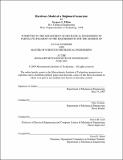Hardware model of a shipboard generator
Author(s)
Elkins, Gregory L. (Gregory Lewis)
DownloadFull printable version (32.34Mb)
Other Contributors
Massachusetts Institute of Technology. Dept. of Mechanical Engineering.
Advisor
Steven B. Leeb.
Terms of use
Metadata
Show full item recordAbstract
A hardware model of the Gas Turbine Generator (GTG) in use on the US Navy's DDG-51 Class Destroyer is constructed for use as a lab apparatus at the Massachusetts Institute of Technology's Laboratory for Electromagnetic and Electronic Systems (LEES). The components of the hardware model include a 5 kilowatt three-phase generator; DC power supplies and motors that function as the prime mover; computer software to implement speed and voltage control; and an input-output interface board that passes measurement and controller signals to and from the software environment. A numerical Simulink model of the GTG is developed that provides speed response to a change in electrical loading. The GTG model takes into account basic physical characteristics of gas turbine generators and is tuned to provide a response similar to that of the destroyer's Allison 501-K34 GTG. An empirical open-loop model of the tabletop generator is also developed in Simulink and subsequently provided with closed-loop feedback control. Controller gains are adjusted such that the tabletop's Simulink model provides a response likened to the GTG model. Proportional and Integral (PI) control of the tabletop generator is implemented in the software environment. The tabletop generator's response to a certain electrical transient is compared to the GTG response predicted by the Simulink model. Recommendations to improve the response of the tabletop generator are made based on analysis of actual speed sensor noise.
Description
Thesis (Nav. E. and S.M.)--Massachusetts Institute of Technology, Dept. of Mechanical Engineering, 2009. This electronic version was submitted by the student author. The certified thesis is available in the Institute Archives and Special Collections. Includes bibliographical references (p. 65).
Date issued
2009Department
Massachusetts Institute of Technology. Department of Mechanical EngineeringPublisher
Massachusetts Institute of Technology
Keywords
Mechanical Engineering.